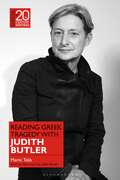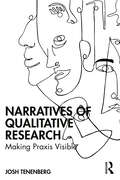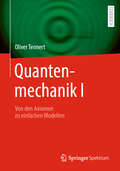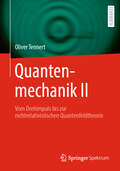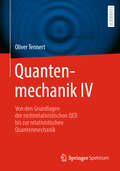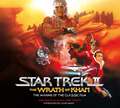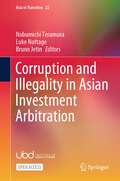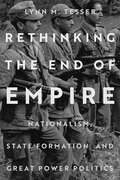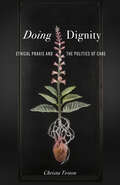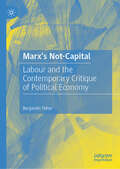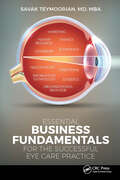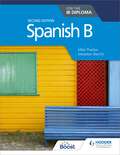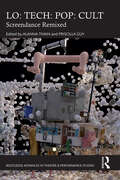- Table View
- List View
Theorie beruflicher Didaktik: Philosophische Reflexionen und pädagogische Perspektiven (Pädagogik)
by Ruben Tecklenburg-RapskeWie kann das Fundament einer Theorie beruflicher Didaktik aussehen, die den Anspruch der Prozessorientierung in aller Tiefe und Breite aufnimmt? Ruben Tecklenburg-Rapske verknüpft zentrale Ansätze der Philosophie, Bildungstheorie und Didaktik. Er entwickelt so miteinander verzahnte, modellhafte Vorschläge, die bestehende theoretische Grundlagen ergänzen oder ersetzen. Die pädagogisch didaktische Theorie wird dadurch als eigenständig erfahrungsbezogener Zusammenhang von Begriffen, Urteilen und Schlüssen fassbar, in dem komplexe Themen und Fragen der Berufspädagogik neu diskutierbar sind.
Chef Tee's Caribbean Kitchen
by Chef TeeBring the joy of Caribbean cooking to your kitchen and discover 80 varied and exciting recipes, from street food grills to one-pot stews, salads and rum-based cocktails. Caribbean cuisine offers a world of flavour from Jamaica to Trinidad and Tobago and everything in between, all the islands have their own unique dishes and cooking styles. In this sunshine filled book you'll find recipes for mouth-watering hot sauces, spice rubs, fragrant marinades and cool chutneys as well as vibrant salads, BBQ wood grills and slowly simmered braises. Food is often eaten on the go from beach shacks or street vendors, who cook up fresh bites every day. Satisfying curries are always on the menu and are traditionally served with rice or Indian-style roti breads for wiping your plate clean, and vegetable sides. Meat is a big feature, often marinated, and fresh fish is readily available, particularly on the smaller islands, but there are plenty of vegetarian and vegan dishes to enjoy too. And let's not forget the rum-based cocktails! Celebrate the fresh and vibrant colours and tastes of the Caribbean in your own kitchen with delicious and easy recipes, filled with lip-smacking flavour and guaranteed to transport you to paradise.
Telling Stories of Pain and Hope: Museums in South Africa and Ireland (ISSN)
by Ruth Teer-Tomaselli Mary Elizabeth LangeThe histories of South Africa and Ireland have been tumultuous and traumatic. Both countries have experienced political repression, sectarian violence and oppression that still impact the spiritual well-being of people today. Their parallel histories are of colonialism, displacement and division, and a fight for land and sovereignty. Both countries have embarked on a process of healing and reconciliation, yet there is an ongoing struggle for reparation and/or reversal of previous injustices.Recognising that museums of the 21st century have the potential to contribute to catharsis and mutual understanding, this book reflects on selected museums in South Africa and Ireland that commemorate the pain of the past and the hope for the future. The primary focus of the book is the way in which museum guides, curators and managers share their stories and the stories of their ancestors, and the stories of other people’s ancestors who were caught up in the conflict while interweaving the stories of the authors as well.Print edition not for sale in Sub Saharan Africa.
Telling Stories of Pain and Hope: Museums in South Africa and Ireland (ISSN)
by Ruth Teer-Tomaselli Mary Elizabeth LangeThe histories of South Africa and Ireland have been tumultuous and traumatic. Both countries have experienced political repression, sectarian violence and oppression that still impact the spiritual well-being of people today. Their parallel histories are of colonialism, displacement and division, and a fight for land and sovereignty. Both countries have embarked on a process of healing and reconciliation, yet there is an ongoing struggle for reparation and/or reversal of previous injustices.Recognising that museums of the 21st century have the potential to contribute to catharsis and mutual understanding, this book reflects on selected museums in South Africa and Ireland that commemorate the pain of the past and the hope for the future. The primary focus of the book is the way in which museum guides, curators and managers share their stories and the stories of their ancestors, and the stories of other people’s ancestors who were caught up in the conflict while interweaving the stories of the authors as well.Print edition not for sale in Sub Saharan Africa.
Hardware Security: A Look into the Future
by Mark Tehranipoor Farimah Farahmandi Navid Asadizanjani Kimia Zamiri Azar Hadi Mardani Kamali Fahim RahmanThis book provides a look into the future of hardware and microelectronics security, with an emphasis on potential directions in security-aware design, security verification and validation, building trusted execution environments, and physical assurance. The book emphasizes some critical questions that must be answered in the domain of hardware and microelectronics security in the next 5-10 years: (i) The notion of security must be migrated from IP-level to system-level; (ii) What would be the future of IP and IC protection against emerging threats; (iii) How security solutions could be migrated/expanded from SoC-level to SiP-level; (iv) the advances in power side-channel analysis with emphasis on post-quantum cryptography algorithms; (v) how to enable digital twin for secure semiconductor lifecycle management; and (vi) how physical assurance will look like with considerations of emerging technologies. The main aim of this book is to serve as a comprehensive and concise roadmap for new learners and educators navigating the evolving research directions in the domain of hardware and microelectronic securities. Overall, throughout 11 chapters, the book provides numerous frameworks, countermeasures, security evaluations, and roadmaps for the future of hardware security.
Reading Greek Tragedy with Judith Butler (Classical Receptions in Twentieth-Century Writing)
by Professor Mario TelòConsidering Butler's “tragic trilogy”-a set of interventions on Sophocles' Antigone, Euripides' Bacchae, and Aeschylus's Eumenides-this book seeks to understand not just how Butler uses and interprets Greek tragedy, but also how tragedy shapes Butler's thinking, even when their gaze is directed elsewhere. Through close readings of these tragedies, this book brings to light the tragic quality of Butler's writing. It shows how Butler's mode of reading tragedy-and, crucially, reading tragically-offers a distinctive ethico-political response to the harrowing dilemmas of our current moment. Deeply committed both to critical theory and political activism, Judith Butler is one of the most influential intellectuals today. Their ideas have touched the lives of many people, both readers and those who have never heard Butler's name. In encompassing gender performativity and sexual difference, vulnerability and precarity, disidentification and bodily interdependency, as well as the politics of protest, Butler's work is often predicated on a strong engagement with or proximity to Greek tragedy.
Reading Greek Tragedy with Judith Butler (Classical Receptions in Twentieth-Century Writing)
by Professor Mario TelòConsidering Butler's “tragic trilogy”-a set of interventions on Sophocles' Antigone, Euripides' Bacchae, and Aeschylus's Eumenides-this book seeks to understand not just how Butler uses and interprets Greek tragedy, but also how tragedy shapes Butler's thinking, even when their gaze is directed elsewhere. Through close readings of these tragedies, this book brings to light the tragic quality of Butler's writing. It shows how Butler's mode of reading tragedy-and, crucially, reading tragically-offers a distinctive ethico-political response to the harrowing dilemmas of our current moment. Deeply committed both to critical theory and political activism, Judith Butler is one of the most influential intellectuals today. Their ideas have touched the lives of many people, both readers and those who have never heard Butler's name. In encompassing gender performativity and sexual difference, vulnerability and precarity, disidentification and bodily interdependency, as well as the politics of protest, Butler's work is often predicated on a strong engagement with or proximity to Greek tragedy.
Fun and Games with the Totterings
by Annie TempestAnnie Tempest has been called a national treasure for her much-lauded and internationally loved cartoon strip about a fictitious English village with the eccentric Lord and Lady Tottering and their family who reside at Tottering Hall. During the thirty years that 'Tottering-by-Gently' has appeared weekly in Country Life magazine, the Tottering family – all three generations of them – have been seen enjoying diverse pastimes and sporting pursuits including tennis, riding, skiing, golf, sailing, fishing and cricket. This latest, keenly anticipated offering is illustrated with more than 100 of Annie's superb colour cartoons and is a winning celebration of the Totterings – and the British – at play.
Narratives of Qualitative Research: Making Praxis Visible
by Josh TenenbergNarratives of Qualitative Research uses a novel form of writing about how to do qualitative research called a praxis narrative. Each narrative is told from the author’s perspective in carrying out one of his past research studies in the social sciences.Told chronologically and in a first-person voice, the narratives position the reader alongside the narrator so as to vicariously experience how research happens in its situated particulars. Rather than a set of idealizations and universalized pronouncements, the author reveals what really goes on when one is in the thick of complex and challenging research studies, the points of trouble along with the successes. This will be relevant to researchers who have already undertaken one or more empirical research studies (though not necessarily using qualitative approaches) and now find themselves facing something new: a new analytic method, a new theoretical lens, a new form of data collection, a new domain of research questions, a new rhetorical approach. This requires letting go of the secure handholds of prescribed methods and responding to the contingencies that arise in the midst of the research. The reader is invited to follow along as the author makes visible his praxis of qualitative research.Unlike more conventional texts, in this unique alternative, the reader can follow the author's journey through his research studies as a way to reorient their conception of qualitative research and their own praxis of it. This is fascinating reading for qualitative researchers and students taking qualitative research courses, across the social sciences, education, and behavioural sciences.
Narratives of Qualitative Research: Making Praxis Visible
by Josh TenenbergNarratives of Qualitative Research uses a novel form of writing about how to do qualitative research called a praxis narrative. Each narrative is told from the author’s perspective in carrying out one of his past research studies in the social sciences.Told chronologically and in a first-person voice, the narratives position the reader alongside the narrator so as to vicariously experience how research happens in its situated particulars. Rather than a set of idealizations and universalized pronouncements, the author reveals what really goes on when one is in the thick of complex and challenging research studies, the points of trouble along with the successes. This will be relevant to researchers who have already undertaken one or more empirical research studies (though not necessarily using qualitative approaches) and now find themselves facing something new: a new analytic method, a new theoretical lens, a new form of data collection, a new domain of research questions, a new rhetorical approach. This requires letting go of the secure handholds of prescribed methods and responding to the contingencies that arise in the midst of the research. The reader is invited to follow along as the author makes visible his praxis of qualitative research.Unlike more conventional texts, in this unique alternative, the reader can follow the author's journey through his research studies as a way to reorient their conception of qualitative research and their own praxis of it. This is fascinating reading for qualitative researchers and students taking qualitative research courses, across the social sciences, education, and behavioural sciences.
Quantenmechanik I: Von den Axiomen zu einfachen Modellen
by Oliver TennertIn einer umfassenden Darstellung entwickeln und vertiefen die vier Bände dieses Lehrbuchs das Gebäude der nichtrelativistischen Quantenmechanik, weshalb sie auch bestens als Nachschlagewerk geeignet sind. Der erste Band beginnt mit einer anekdotenreichen und spannenden historischen Überblicksdarstellung, die die Hauptprotagonisten der Quantentheorie und wichtige Meilensteine ihres Wirkens vorstellt. Im Folgenden wird dann die Formulierung im Hilbert-Raum axiomatisch entwickelt und wichtige Grundlagenthemen behandelt: die eindimensionalen Probleme, der harmonische Oszillator und die WKB-Näherung als Bindeglied zur klassischen Physik. Besonderheiten: Auch komplizierte Zusammenhänge werden illustrativ und klar erklärt. Zahlreiche mathematische Einschübe erläutern allgemeine mathematische Zusammenhänge. Besondere Highlights des Buches sind die frühe Entwicklung von Propagatormethoden, die ausführliche mathematische Behandlung von kohärenten und gequetschten Zuständen des harmonischen Oszillators, sowie die gründliche Untersuchung des klassischen Grenzfalls. Inhalt 1. Historischer Abriss: Der Weg zur Quantenmechanik - 2. Der theoretische Formalismus der Quantenmechanik - 3. Eindimensionale Probleme - 4. Der harmonische Oszillator in der Quantenmechanik - 5. Die WKB-Näherung und der klassische Grenzfall Zielgruppe: Das Buch richtet sich sowohl an Bachelor- als auch an Masterstudierende sowie ihre Lehrenden. Aufgrund seines mehrbändigen Charakters, der breiten Themenvielfalt und Bezügen zu wissenschaftlichen Originalarbeiten allerdings ein Muss für jedes Bücherregal einer in der Physik tätigen Person. Vorkenntnisse: Vorausgesetzt werden Kenntnisse der Theoretischen Mechanik, der Elektrodynamik und der Speziellen Relativitätstheorie, sowie der Analysis, der linearen Algebra und der Funktionentheorie.
Quantenmechanik II: Vom Drehimpuls bis zur nichtrelativistischen Quantenfeldtheorie
by Oliver TennertIn einer umfassenden Darstellung entwickeln und vertiefen die vier Bände dieses Lehrbuchs das Gebäude der nichtrelativistischen Quantenmechanik, weshalb sie auch bestens als Nachschlagewerk geeignet sind. Der zweite Band behandelt den quantenmechanischen Drehimpuls, sowie Symmetrien in der nichtrelativistischen Quantenmechanik. Anschließend wird das wichtige Anwendungsgebiet der dreidimensionalen Probleme sowohl auf algebraischem Wege als auch mit analytischen Methoden untersucht. Es schließen sich Kapitel zu Teilchen in elektromagnetischen Feldern und zum großen Themenkomplex identischer Teilchen an, welcher nahtlos zur Feldquantisierung weiterführt. Besonderheiten: Auch komplizierte Zusammenhänge werden illustrativ und klar erklärt. Zahlreiche mathematische Einschübe erläutern allgemeine mathematische Zusammenhänge. Besondere Highlights des Buches sind der algebraische Beweis zur Ganzzahligkeit des Bahndrehimpulses, die ausführliche Untersuchung des Zusammenhangs zwischen Clifford-Algebren und Spinoren, sowie ein Linearisierungsansatz für die Schrödinger-Gleichung. Die Mathematik der Eichtheorien bietet eine zusammenhängende Formulierung sehr vieler topologischer Phänomene wie magnetischer Monopole, des Aharonov–Bohm-Effekts oder von Landau-Niveaus. Inhalt 1. Theorie des Drehimpulses I - 2. Symmetrien in der Quantenmechanik I - 3. Dreidimensionale Probleme - 4. Teilchen in elektromagnetischen Feldern - 5. Theorie des Drehimpulses II - 6. Identische Teilchen und nichtrelativistische Quantenfeldtheorie Zielgruppe: Das Buch richtet sich sowohl an Bachelor- als auch an Masterstudierende sowie ihre Lehrenden. Aufgrund seines mehrbändigen Charakters, der breiten Themenvielfalt und Bezügen zu wissenschaftlichen Originalarbeiten allerdings ein Muss für jedes Bücherregal einer in der Physik tätigen Person. Vorkenntnisse: Vorausgesetzt werden Kenntnisse der Theoretischen Mechanik, der Elektrodynamik und der Speziellen Relativitätstheorie, sowie der Analysis, der linearen Algebra und der Funktionentheorie.
Quantenmechanik IV: Von den Grundlagen der nichtrelativistischen QED bis zur relativistischen Quantenmechanik
by Oliver TennertIn einer umfassenden Darstellung entwickeln und vertiefen die vier Bände dieses Lehrbuchs das Gebäude der nichtrelativistischen Quantenmechanik, weshalb sie auch bestens als Nachschlagewerk geeignet sind. Der vierte Band beginnt mit einem ausführlichen Kapitel zur nichtrelativistischen Quantenelektrodynamik (QED), traditionell als "Quantentheorie der Strahlung" bezeichnet, und leitet dann über in die relativistische Quantentheorie. Eine sorgfältige Behandlung der Möglichkeiten und Grenzen einer relativistischen Quantenmechanik sowie eine gründliche Untersuchung von Symmetrien in der relativistischen Quantentheorie schließen das Lehrbuch ab. Besonderheiten: Auch komplizierte Zusammenhänge werden illustrativ und klar erklärt. Zahlreiche mathematische Einschübe erläutern allgemeine mathematische Zusammenhänge. Besondere Highlights des Buches sind eine ausführliche Diskussionder Lamb-Verschiebung und des Casimir-Effekts, einschließlich der in diesem Zusammenhang offenbar werdenden Problematik der Renormierung, sowie die Analyse der Einteilchen-Interpretation in der relativistischen Quantenmechanik und die Betrachtung von Gruppenkontraktionen im Übergang von relativistischen zu nichtrelativistischen Symmetriegruppen und ihrer Darstellungen. Inhalt 1. Quantisierung des elektromagnetischen Feldes - 2. Relativistische Quantenmechanik - 3. Symmetrien in der Quantenmechanik II Zielgruppe: Das Buch richtet sich sowohl an Bachelor- als auch an Masterstudierende sowie ihre Lehrenden. Aufgrund seines mehrbändigen Charakters, der breiten Themenvielfalt und Bezügen zu wissenschaftlichen Originalarbeiten allerdings ein Muss für jedes Bücherregal einer in der Physik tätigen Person. Vorkenntnisse: Vorausgesetzt werden Kenntnisse der Theoretischen Mechanik, der Elektrodynamik und der Speziellen Relativitätstheorie, sowie der Analysis, der linearen Algebra und der Funktionentheorie.
Star Trek II: The Wrath of Khan - The Making of the Classic Film
by John Tenuto Maria Jose TenutoStar Trek II: The Wrath of Khan - The Making of the Classic Film. Description, yet to be announced.
Life Sciences Research and Scientific Writing
by Benno ter KuileScientific writing is a trade that can and must be learned and not a form of art that is limited to the talented. The real constraint for writing a good scientific article is most of the time not the usage of the English language, but the conversion of outcomes of a set of experiments into a coherent and convincing scientific story. This book is designed to guide junior scientists in the Life Sciences writing their thesis and first manuscripts, along this uphill struggle. All aspects of building up and publishing a forceful scientific narrative are covered, from designing experiments to dealing with the reviewers’ comments. This book takes you step by step through the process of writing a paper. It starts by discussing how to collect and organize data and make an outline. The actual writing starts with the Results section, as this is the heart of any research paper. The Discussion interprets your data in the framework of the existing literature and explains the novel insights you obtained. The Introduction is written to pose the questions that are answered in the Discussion and give the necessary background information. It is written after the Results and Discussion to make sure it is a perfect match. The M&M is the easiest to write. A good abstract is essential for attracting readers. How to write that is described in detail. The title is the last piece of the puzzle. The book contains many practical examples that explain the general principles of good writing. These examples are all from the Life Sciences and so are the anecdotes that illustrate the concepts, making the information directly applicable. All kinds of tips and suggestions are provided for improving readability and accessibility of your manuscript, thus making it easier acceptable. In addition, background information on the basics of science is supplied that helps to avoid common mistakes that cause rejection of manuscripts that report on otherwise good science.
Corruption and Illegality in Asian Investment Arbitration (Asia in Transition #22)
by Nobumichi Teramura Luke Nottage Bruno JetinThis open access book explores Asian approaches towards investment arbitration—a transnational procedure to resolve disputes between a foreign investor and a host state—setting it in the wider political economy and within domestic law contexts. It considers the extent to which significant states in Asia are, or could become, “rule makers” rather than “rule takers” regarding corruption and serious illegality in investor-state arbitration. Corruption and illegality in international investment are widely condemned in any society, but there remains a lack of consensus on the consequences, especially in investment arbitration. A core issue addressed is whether a foreign investor violating a host state’s law should be awarded protection of its investment, as per its contract with the host state and/or the applicable investment or trade agreement between the home state and the host state. Some suggest such protection would be unnecessary as the investor committed a crime in the host state, while others attempt to establish an equilibrium between the investor and the host state. Others claim to protect investment, invoking the sanctity of promises made. The book starts with a deep dive into economic and legal issues in corruption and investment arbitration and then explores the situation and issues in major countries in the region in detail. It is a useful reference point for lawyers, economists, investors, and government officials who are seeking comprehensive and up-to-date information on anti-bribery rules in Asian investment treaties. It is of particular interest to students and researchers in economics, finance, and law, who are undertaking new research relating to the multifaceted impacts of corruption.
Rethinking the End of Empire: Nationalism, State Formation, and Great Power Politics
by Lynn M. TesserWhy did a nation-state order emerge when nationalist activism was usually an elitist pursuit in the age of empire? Ordinary inhabitants and even most indigenous elites tended to possess religious, ethnic, or status-based identities rather than national identities. Why then did the desires of a typically small number result in wave after wave of new states? The answer has customarily centered on the actions of "nationalists" against weakening empires during a time of proliferating beliefs that "peoples" should control their own destiny. This book upends conventional wisdom by demonstrating that nationalism often existed more in the perceptions of external observers than of local activists and insurgents. Lynn M. Tesser adds nuance to scholarship that assumes most, if not all, pre-independence unrest was nationalist and separatist, and sheds light on why the various demands for change eventually coalesced around independence in some cases but not others.
Rethinking the End of Empire: Nationalism, State Formation, and Great Power Politics
by Lynn M. TesserWhy did a nation-state order emerge when nationalist activism was usually an elitist pursuit in the age of empire? Ordinary inhabitants and even most indigenous elites tended to possess religious, ethnic, or status-based identities rather than national identities. Why then did the desires of a typically small number result in wave after wave of new states? The answer has customarily centered on the actions of "nationalists" against weakening empires during a time of proliferating beliefs that "peoples" should control their own destiny. This book upends conventional wisdom by demonstrating that nationalism often existed more in the perceptions of external observers than of local activists and insurgents. Lynn M. Tesser adds nuance to scholarship that assumes most, if not all, pre-independence unrest was nationalist and separatist, and sheds light on why the various demands for change eventually coalesced around independence in some cases but not others.
Doing Dignity: Ethical Praxis And The Politics Of Care (Health Communication Ser.)
by Christa TestonMarx’s Not-Capital: Labour and the Contemporary Critique of Political Economy
by Benjamin TetlerAs a contribution to critical social theory, this book reconsiders Marx’s critique of political economy through the concept of labour as “not-capital”. Engaging with thinkers who have dealt with Marx’s concepts of “not-capital” and “not-value”, Tetler examines whether and how these concepts can contribute significantly towards a renewal of the critique of political economy beyond the limits of traditional Marxism. In doing so he provides the first in depth interrogation of these concepts, both within Marx’s work itself and within and across the various intellectuals who have put them to use in their attempts to address the faults of traditional Marxism. He argues that the theory of value that sits at the heart of Marx’s critique of political economy requires a negative conception of labour. In helping establish this, the notions of labour as not-capital/value are shown to have formidable ramifications concerning the crisis-ridden nature of capitalist social relations and the struggles operative within and against them.
Essential Business Fundamentals for the Successful Eye Care Practice
by Savak TeymoorianA compact business education that strategically incorporates 500 keywords to lay the foundation and over 50 action items to initiate meaningful advances and excel in your eye care practice today.
Essential Business Fundamentals for the Successful Eye Care Practice
by Savak TeymoorianA compact business education that strategically incorporates 500 keywords to lay the foundation and over 50 action items to initiate meaningful advances and excel in your eye care practice today. Medical training is a difficult journey with enormous amounts of information to absorb over a short time period. The intense time commitment required during this process leaves little opportunity to study any other discipline. However, even the most intelligent and well-intentioned provider cannot care for patients if the front door of the building is closed. Simply put: A fundamental background in business is required to effectively practice medicine. Eye care professionals, which includes their ophthalmic staff, can now fill the critical gap in their education with Essential Business Fundamentals for the Successful Eye Care Practice, providing them the necessary basic tools to make and execute winning practice management decisions. Writing in a high-density format that medical professionals will be familiar with, Dr. Savak Teymoorian combines his physician training and experience as a successful ophthalmologist at Harvard Eye Associates with the knowledge acquired earning his MBA. This unique perspective allows him to provide the proper theory and execution in the business of eye care and present it in an efficient manner like that used in medical education. Each chapter is dedicated to a different subject that would routinely be taught in a masters of business administration degree, tailored specifically for eye care professionals and distilled into the most critical information for a strong foundation. Each section is further enhanced with real life examples seen in ophthalmic care showing how to properly apply business strategies and tactics to obtain the best results.Chapter topics include: Marketing Leadership Negotiations Operations Finance Ophthalmologists, optometrists, and eye care staff will appreciate Essential Business Fundamentals for the Successful Eye Care Practice for its efficient and relevant information to running an eye care practice, whether they are currently in training and want to set themselves up for success or they are already practicing and want to fill in a deficiency in their knowledge.
Spanish B for the IB Diploma Second Edition
by Mike Thacker Sebastian BianchiExam board: International BaccalaureateLevel: IB DiplomaSubject: SpanishFirst teaching: September 2018First exams: Summer 2020Develop competent communicators who can demonstrate a sound conceptual understanding of the language with a flexible course that ensures thorough coverage of the updated Spanish B Guide and is designed to meet the needs of all IB students at Standard and Higher Level.- Empower students to communicate confidently by exploring the five prescribed themes through authentic texts and skills practice at the right level, delivered in clear learning pathways. - Ensure students are able to produce coherent written texts and deliver proficient presentations with grammar and vocabulary introduced in context and in relation to appropriate spoken and written registers. - Improve receptive skills with authentic written texts, audio recordings spoken at a natural pace, and carefully crafted reading and listening tasks.- Promote global citizenship, intercultural understanding and an appreciation of Hispanic cultures through a wide range of text types and cultural material from around the world. - Deliver effective practice with a range of structured tasks within each unit that build reading, listening, speaking and writing skills.- Establish meaningful links to TOK and CAS, and identify learner profile attributes in action.The audio for the Student Book is FREE to download from www.hoddereducation.com/ibextras
LO: Screendance Remixed (ISSN)
by Alanna Thain Priscilla GuyThis edited collection assembles international perspectives from artists, academics, and curators in the field to bring the insights of screendance theory and practice back into conversations with critical methods, at the intersections of popular culture, low-tech media practices, dance, and movement studies, and the minoritarian perspectives of feminism, queer theory, critical race studies and more.This book represents new vectors in screendance studies, featuring contributions by both artists and theoreticians, some of the most established voices in the field as well as the next generation of emerging scholars, artists, and curators. It builds on the foundational cartographies of screendance studies that attempted to sketch out what was particular to this practice. Sampling and reworking established forms of inquiry, artistic practice and spectatorial habits, and suspending and reorienting gestures into minoritarian forms, these conversations consider the affordances of screendance for reimaging the relations of bodies, technologies, and media today.This collection will be of great interest to students and scholars in dance studies, performance studies, cinema and media studies, feminist studies, and cultural studies.
Women in Central and Southeastern Europe, 1700–1900: Life, Literacy, and Social Entanglements in a Transnational Setting
by Polly ThanailakiThis book explores portraits of significant women living in central and southeastern Europe whose lives and activities remain unknown, uncovering their lifestyles as well as the social entanglements relating to their education. The book also examines transnationality and modernity, arguing that during the eighteenth to nineteenth centuries transculturality as a cultural marker was in contrast with national fallacies. In addition to this, it provides insight into the controversies concerning women’s social standing, and it investigates the prevailing social norms, restrictions, and biases that affected their lives. The book draws on a wide range of original printed sources such as school archives, government documents, newspapers, and journals as well as secondary sources of literature.




